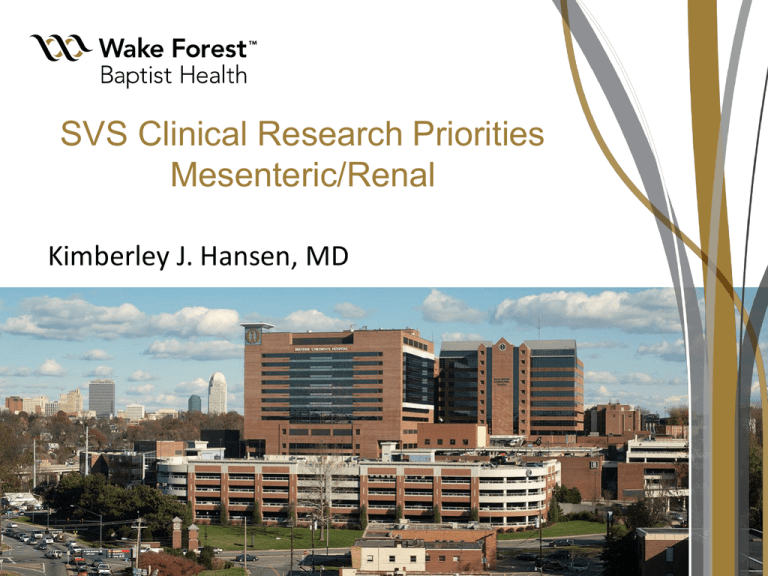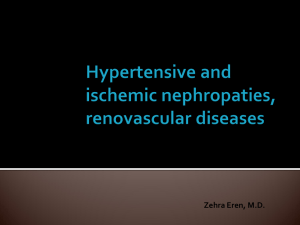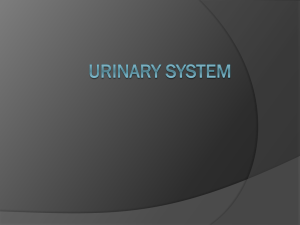MesentericRenalDisease
advertisement

SVS Clinical Research Priorities Mesenteric/Renal Kimberley J. Hansen, MD ACE inhibitor Rx Calcium Blockers PTRA introduced Cooperative study of renovascular hypertension Improved surgery Small, randomized trials Urgent bilateral nephrectomy for treatment resistant, malignant HTN Med Rx vs PTRA Prospective trials: Med Rx vs Stent Therapy CORAL ASTRAL STAR RAVE Function tests: Blood flow, sodium excretion Renal artery clip hypertension 1930 Surgery for renal reconstruction 1940 Nephrectomy for hypertension with a small kidney Wake Forest Baptist Health 1950 1960 Early imaging: intravenous pyelography scan 1970 1980 1990 2000 ARB Rx Advanced imaging: MRA, CTA Statin therapy Stents ACE inhibitor Rx Calcium Blockers PTRA introduced Cooperative study of renovascular hypertension Improved surgery Small, randomized trials Urgent bilateral nephrectomy for treatment resistant, malignant HTN Med Rx vs PTRA Prospective trials: Med Rx vs Stent Therapy CORAL ASTRAL STAR RAVE Function tests: Blood flow, sodium excretion Renal artery clip hypertension 1930 Surgery for renal reconstruction 1940 Nephrectomy for hypertension with a small kidney Wake Forest Baptist Health 1950 1960 Early imaging: intravenous pyelography scan 1970 1980 1990 2000 ARB Rx Advanced imaging: MRA, CTA Statin therapy Stents Prevalence of Renovascular Lesions • CHS Participants > 65 years • Patients – Coronary Arteriography 6-7% 6-18% • Patients – Aortography 16-40% • ‘NEW’ Hypertensives > 60 years 20-30% DBP > 110/mmHg J Vasc Surg 2002;36:443-451, Am Heart J 1998,136:913-918, Cathet Cardiovasc Diagn 1994;32:8-10, J Am Soc Nephrol 1992;2:1608-1616, Am J Med 1990;88:46N-51N, Ann Vasc Surg 1998;12:17-22, J Vasc Surg 1993;18:433-440, Am J Med 2000;109:642-647, J Am Hypertension 1996;10:83-85, Am J Med 1994;96:10-14, Int Angiol 1992;11:195-199 Wake Forest Baptist Health CMS PTRA-S Procedures Renal Angioplasty Renal Stent Both Renal Angioplasty and Stent Total, 5% file Extrapolated to 100% 1996 189 61 133 383 7,660 1998 192 120 258 570 11,400 2000 219 287 420 926 18,520 Note. - Procedure totals are from 5% files for analysis of codes 35471, 37205, and both, respectively. Results from the 5% Part B files were multiplied by 20 to yield “extrapolated to 100%” totals. AJR 2004; 183:561-568 Wake Forest Baptist Health PTRA-S per 100,000 CMS Region Keystone Southeast South Great Lakes Pacific Southwest Great Western Other Mid-Atlantic North East National 1996 1998 2000 % Increasea 12 22 30 25 14 32 38 5 38 18 25 26 41 46 40 30 53 39 14 45 19 38 57 86 87 62 31 71 70 9 62 26 61 482 387 287 253 228 223 186 178 166 142 239 Note. - Overall utilization pooled for all regions is listed in the last row (these numbers differ slightly from the average of each region because of slight differences in number of beneficiaries among regions, particularly the low-utilization, sparsely populated “other” region). Average utilization in 2000 ranged from 26 to 87 per 100,000 (excluding “other”). CMS regions are Mid-Atlantic: DE, DC, IN, MD, OH, VA, WV; Southwest: AR, CO, LA, NM, OK, TX; Northeast: CT, ME, MA, NH, NY, RI, VT; Great Lakes: IL, IA, MI, MN, WI; Great Western: AK, ID, KS, MO, MT, NE, ND, OR, SD, UT, WA, WY; Keystone: NJ, PA; Southeast: AL, KY, MS, NC, SC, TN; South: FL, GA Pacific: AZ, CA, HI, NV; Other: Puerto Rico, Virgin Island. CMS = Centers for Medicare and Medicaid Services. aGrowth in annual procedure volume when compairing 2000 with 1996 AJR 2004; 183:561-568 Wake Forest Baptist Health Annual PTRA-S Volume Physician Specialty 1996 (%) 1998 (%) 2000 (%) % of Increasea Cardiology Radiology Surgery Other 2,380 (31) 4,700 (61) 300 (4) 280 (4) 5,060 (44) 5,380 (61) 480 (4) 480 (4) 9,220 (50) 7,660 (41) 760 (4) 880 (5) 287 63 153 214 7,660 11,400 18,520 142 Total Note. - Physicians identifying their specialty as cardiology or internal medicine are considered cardiologists in this table, those reporting their specialty as interventional radiology or radiology are identified as radiologists, and those reporting their specialty as vascular surgery or general surgery are categorized as surgeons. These specialties accounted for more than 95% of providers submitting claims for renal artery interventional procedures for each year. aGrowth in annual procedure volume when comparing 2000 with 1996 AJR 2004; 183:561-568 Wake Forest Baptist Health Frequency of PTRA-S 2005 National Inpatient Sample Region South Northeast Midwest West Totals Overall Weighted % Frequency (SD) Hospitalization Empirical RA-PTAS Prophylactic RA-PTAS 30,457 (2,484) 15,300 (1,847) 17,955 (1,634) 12,221 (1,393) 0.20 0.20 0.20 0.16 23,635 11,055 13,548 9,049 6,822 4,245 4,407 3,172 75,933 -- 57,287 18,646 Estimated Health Cost Expenditure – 75,933 x (5,136 + 723) 444,891,447 Source: National Inpatient Sample (Unpublished) Wake Forest Baptist Health 2007 MedCAC Voting Questions Highly Confident (5) – Not Confident (1) 1. For the treatment of patients with atherosclerotic RAS, how confident are you that the evidence is adequate to draw conclusions about safety and clinical effectiveness of the following renal artery interventions: Overall Average a) b) c) d) Surgical renal artery reconstruction (RAR)? PTRA without stent placement? PTRAS with bare metal stents? PTRAS with drug-eluting stents? Wake Forest Baptist Health 2.92 2.92 2.85 1.00 2007 MedCAC Voting Questions Highly Confident (5) – Not Confident (1) 2. Based on the evidence presented, how confident are you that the published results apply to : Overall Average a) Medicare patients with typical comorbidities? b) Providers (facilities/physicians) in community practice? Wake Forest Baptist Health 3.69 2.15 2007 MedCAC Voting Questions Highly Confident (5) – Not Confident (1) 3. Based on the evidence presented for patients with atherosclerotic RAS, how confident are you that compared to aggressive medical treatment alone there are improved key health outcomes attributable to the following co-interventions: Overall Average a) b) c) d) Surgical renal artery reconstruction (RAR)? PTRA without stent placement? PTRAS with bare metal stents? PTRAS with drug-eluting stents? Wake Forest Baptist Health 2.31 2.08 3.15 N/A 2007 MedCAC Voting Questions Strongly Agree(1) – Strong Disagree(5) 4. Based on the evidence presented, should Medicare national coverage of any non-medical treatments for atherosclerotic RAS be limited only to patients enrolled in qualified clinical research studies? Overall Average 2.23 Wake Forest Baptist Health Prospective Randomized Clinical Trials PTRA versus Open Repair • Single center, Malmö • Inclusion < 70 years No diabetes Hypertension with unilateral RA stenosis • RVH defined by RVRA’s • GFR estimated by Cr-EDTA clearance • Angiographic follow-up for all • PTRA primary/secondary patency 75%/90% Surgical 96%/97% • PTRA HTN cured/improved 83% Surgical 89% • Non-representative patient cohort Significant difference baseline GFR PTRA crossover to surgery • No Endoluminal stents J Vasc Surg 1993;18:841-850 Wake Forest Baptist Health Early Prospective Randomized Trials Trial Patients (n) Unilateral or Bilateral Disease Randomized Treatment Duration of Follow-Up Main Endpoints Webster et al SNRASCO 55 Unilateral and bilateral, but two groups analyzed separately Angioplasty v medical management Patients reviewed at end of 4-week run-in period (baseline) then at 1, 3, and 6 months, then at 6-month intervals Primary: BP and SCr at 6 months and the change in these from baseline Plouin et al EMMA 49 Unilateral only Angioplasty (with or without stent insertion) v medical management Patients reviewed at end of 2-6 week runin period (baseline) then at 6 months Primary: BP at termination* and the change from baseline Secondary: treatment score and incidence of complications van Jaarsveld et al DRASTIC 106 Unilateral and Bilateral Angioplasty v medical management Patients reviewed every 1-3 months, and always at 3 and 12 months Primary: BP at 3 and 12 months Secondary: treatment score, SCr, SCr clearance, patency, and incidence of complications From Ives NJ, Wheatley K, Stowe RL, et al: Continuing uncertainty about the value of percutaneous revascularization in atherosclerotic renovascular disease: a meta-analysis of randomized trials. Nephrol Dial Transplant 2003;18:298-304 adapted with permission. *Termination defined as 6 months after randomization or earlier in cases of refractory hypertension (diastolic blood pressure > 1 to 4 mm/Hg despite maximal tolerated antihypertensive regimen. In such cases, blood pressure, treatment score, and SCr were determined prior to renal arteriograph. Nephrol Dial Transplant 2003;18:298-304 Wake Forest Baptist Health Prospective Randomized Clinical Trials STAR Study • STent placement and blood pressure and lipid-lowering for prevention of progression of renal dysfunction caused by Atherosclerotic ostial stenosis of the Renal artery (Netherlands) • Stenting versus angioplasty alone for ostial RAS • Primary ‘Technical’ Success Stent 88% PTRA 57% • Restenosis Rate Stent 14% PTRA 48% • Primary endpoint: <20% Decline EFGR No difference • Secondary endpoints: HTN, heart and vascular events, mortality No difference • ESRD or mortality in 10% patients J Nephrol 2003;16:807-812 Wake Forest Baptist Health Management Of Renovascular Disease Ongoing Randomized Controlled Trails •Angiopolasty and STent for Renal Artery Lesions (ASTRAL – United Kingdom) •Renal Atherosclerotic ReVascularization Evaluation (RAVE – Canada) •Nephrology Ischemic ThERapy (NITER – Italy) •Renal Artery Stenting in HemoDynamic Atherosclerotic Renal Artery Stenosis (RADAR) – Europe and South America •Cardiovascular Outcomes in Renal Atherosclerotic Lesions (CORAL – United States, Canada, Australia, and New Zealand Prospective Randomized Clinical Trials ASTRAL Trial • Angioplasty and STenting For Renal Artery Lesions • Multicenter: 53 UK, 4 Australia • PTRA-S versus Best Medical Management (Statins, Antiplatelet, Antihypertension THX) • 806 Patients (403 in each group); ‘Uncertain Worth’ • Mean follow up: 33.6 months (all 12 months) Mean degree RAS: 76% diameter reduction 60% > 70% stenosis • Primary endpoint: rate of change EGFR • Secondary endpoints: HTN, heart and vascular events, mortality • No difference in 1o or 2o endpoints N Engl J Med 2009;361:1953-1962 Wake Forest Baptist Health Prospective Randomized Clinical Trials CORAL Trial • Cardiovascular Outcomes in Renal Atherosclerotic Lesions • Multicenter: Enrolled 1050 patients (U.S., Canada, Australia, New Zealand) • PTRA-S versus Best Medical Management • Primary endpoint: composite CV mortality, MI, CHF, CVA, Doubling SCr, ESRD • Secondary endpoints: all cause mortality, EGFR, restenosis, microvascular function, BP control • Renal artery stenoses measured PRIOR to randomization at angiography • Translesional pressure gradients before and after randomization • Distal embolic protection encouraged (complete balloon occlusion) • Recruitment/randomization closed 2010 • Publication/presentation 1/2014 (C. Cooper) Am Heart J 2006;152:59-66 Wake Forest Baptist Health Atherosclerotic Renovascular Disease Multivariate Analysis – Death or Dialysis Variable ß Coefficient Hazard Ratio 95% C.I. P Value Pre-Op EGFR -0.8555 0.43 0.34, 0.54 <0.001 Diabetes Mellitus 0.5313 2.14 1.15, 3.97 0.007 Prior CVA 0.4068 1.50 1.02, 2.22 0.042 Al-Occl 0.5078 1.66 1.19, 2.31 0.003 Pre-Op BP -0.2329 0.79 0.67, 0.94 0.006 BP Cure -0.6637 0.52 0.30, 0.88 0.014 EGFR No Change 0.9259 1.49 1.04, 2.13 0.028 EGFR Worse 0.1070 1.95 1.06, 3.61 0.032 J Vasc Surg 2002;35:236-245 Wake Forest Baptist Health Management of Renovascular Disease PTRA-S and Ischemic Nephropathy Reference/Date Rees CR (1991) Kuhn FP (1991) Joffre F (1992) Hennequin LM (1994) MacLeod M (1995) van de Ven PJG (1995) Dorros G (1995) Henry M (1996) Iannone LA (1996) Harden PN (1997) Blum U (1997) Boisclair C (1997) Rundback JH (1998) Fiala LA (1998) Dorros G (1998) Tuttle KR (1998) Gross CM (1998) Henry M (1999) Rodriguez-Lopez JA (1999) van de Ven PJ (1999) Baumgartner I (2000) Giroux (2000) Lederman (2001) Bush (2001) Zeller (2004) Totals= n/r: Not Reported SCr: Serum Creatinine Renal Dysfunction (# Pts) 14 n/r 4 6 16 n/r 29 10 29 32 20 17 45 9 63 74 12 48 32 29 n/r 21 111 50 239 1017 Function response (%) Improved Unchanged Worsened 36% 36% 29% n/r n/r n/r 50% 50% 0% 20% 40% 40% 25% 75% 33% 58% 8% 28% 28% 45% 20% 80% 36% 46% 18% 35% 35% 29% 0% 100% 0% 41% 35% 24% 18% 53% 30% 0% 100% 0% No change in mean SCr 16% 75% 9% 55% 27% 18% 29% 67% 2% No change in mean SCr 17% 55% 28% 33% 42% 25% 24% 76% 8% 78% 14% 23% 51% 26% 34% 39% 27% 22% 56% 22% HTN Response (%) Cured 11% 22% 27% 7% 0% 0% 6% 18% 4% n/r 16% 6% n/r 1% 2% 0% 19% 13% 15% n/r 10% Improved 5% 34% 64% 93% 40% 73% 46% 57% 35% n/r 62% 61% n/r 53% 42% 46% 69% 61% 55% 43% 43% 53% 70% n/r 46% 51% Restenosis Failed 36% 44% 9% 0% 60% 27% 48% 24% 61% n/r 22% 33% n/r 47% 57% 52% 31% 20% 32% 42% 57% 47% 30% n/r 54% 39% (%) 39% 17% 18% 27% 17% 13% 25% 9% 14% 13% 17% 0% 26% 65% n/r 14% 13% 11% 26% 14% 28% n/r 21% n/r n/r 19% Chronic Mesenteric Ischemia PTVA+S vs. Open Repair Author (Source) Atkins1 (Single Center) Gupta2 (Review) Oderich3 (Review) Symptomatic Relief Morbidity Mortality 10 Patency (1 yr) Open Repair 90% 35% 2% 91% 7% PTVA + S 87% 29% 3% 67% 25% Open Repair 94.4% 34.7% 4.5% 90.8% 22.4% PTVA + S 87.8% 14.1% 4.1% 74.2% 21.7% Open Repair 94% 47% 7% 89% 7% PTVA + S 89% 15% 3% 74% 25% Method Symptomatic Recurrence (1 yr) J Vasc Surg 2007;45:1162-11711 J Endovasc Ther 2010;17:540-5492 Ann Vasc Surg 2009;23:700-7123 Wake Forest Baptist Health Acute Mesenteric Ischemia Percutaneous vs. Open Repair Thrombotic - Embolic In-Hospital Occlusion Mortality Thrombotic - Embolic Mortality Open Repair 36% - 64% 50% 83% - 33% Percutaneous Intervention 72% - 28% 39% 33% - 53% J Vasc Surg 2011;53:698-705 Wake Forest Baptist Health Atherosclerotic Renovascular Disease Summary • Severe Hypertension Key Clinical Characteristic Favoring Presence of Renovascular Disease • Improved Renal Function Key Postoperative Result Favoring of Dialysis-free Survival • Associations With Improved Renal Function • Severe Associated Hypertension • Bilateral Renovascular Disease With Bilateral Reconstruction • Rapidly Deteriorating Renal Function • Test(s) Physiologic Significance/Response Wake Forest Baptist Health







